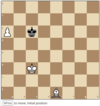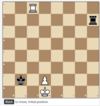Essential Endgames Flashcards
You have King, Bishop and Pawn against King. What are the key factors determining whether you can win or draw?
If the pawn is central (NOT a rook pawn) it is a win.
With a rook’s pawn there are drawing possibilities if the Bishop does not control the queening square if the defending King can get to the queening square first.

You have King, Bishop and Rook Pawn against King. How to draw as White?

- As long as the pawn and bishop are not immediately threatened it is a win unless the pawn is a rook’s pawn.
- If it is a rook’s pawn then the key is:
a) does the Bishop control the queening square - if so it is a win
b) If not the key question is can the Bishop and pawn together with attacking King keep the defending King away from the queening square - if yes it is a win , if no it is a draw

You have King, Bishop and Rook Pawn against King. How to win as White?

If it is a rook’s pawn then the key is:
a) does the Bishop control the queening square - if so it is a win
b) If not the key question is can the Bishop and pawn together with attacking King keep the defending King away from the queening square - if yes it is a win , if no it is a draw

What is the rule of the floating square? i.e. the scenario where one side has two isolated pawns separated by one or more files?

There are cases in which the king must do battle with two separated passed pawns; in these cases, a useful rule is the floating-square rule.
If a square whose two corners are occupied by pawns (on the same rank) reaches the edge of the board, then one of those pawns must queen.
If the square does not reach the edge of the board, then the king can hold the pawns. If there are two files between the pawns, the king can capture both; if the distance is any greater, he can only prevent their further advance. Let’s shift the pawns to a6 and e6 in the example below. The square now reaches only to the second rank, and the position becomes a draw.

King, Rook and pawn versus King and Rook - Lucena
Whare the key points of this ending and what is the technique to win - white to move

Attacking side
1) Pawn advanced and on seventh
2) Attacking King in front of pawn on eight
Defending side
1) Rook cannot issue a check to dislodge attacking King
2) Defending King is cut of from attacking King by at least one file
=> To win the attacking King needs to get out from in front of the pawn but to do this immediately would expose the King to a barrage of checks and the best the attacking King can do is go back to e8
=> Build a bridge with Rg1+ and Rg4 to let the Attacking King get out - with the later idea of Re3+ being met by Re4 and the pawn will queen. If the rook is on d2 this is the only winning method - on other second rank squares Rg1 and Re1/Rd1 also works - so learning Lucena is universal approach.
=> this makes use of three files of separation rule
If there are THREE files/ranks between the checking Rook (Black) and the enemy pawn (White), the Rook can check the enemy King indefinitely. This is because the King is unable to attack the Rook while keeping his pawn defended. In this position, the furthest the White King can stray from his pawn is the fifth rank. Hence, the White Rook must provide cover on the fourth rank.

We have a Lucena position but it is Black to move - what happens and what principles are at work here?

Black’s rook can check the White King King indefinitely from the side - if the King moves to directly attack the Rook then Black either takes the pawn or places itself behind it.
=> this makes use of three files of separation rule
If there are THREE files/ranks between the checking Rook (Black) and the enemy pawn (White), the Rook can check the enemy King indefinitely. This is because the King is unable to attack the Rook while keeping his pawn defended. In this position, the furthest the White King can stray from his pawn is the fifth rank. Hence, the White Rook must provide cover on the fourth rank.

Here the defending King is on the 8th rank in front of the pawn. How to defend as White?

Kh8
You may also remember that when the defender’s King is in front of the attacker’s pawn in K + P vs K endgames (Refer to Positions 2, 3, and 5), the position is drawn. This rule similarly applies in K + R + P vs K + R endgames.
Against Knight pawns or Rook pawns, the defensive technique is simple - place your Rook on the last rank and wait.
If checked by the Rook in front of the pawn go to the cover of the rook file otherwise Ka3 and defeat follows.

King, Rook and Pawn versus King and Rook
What are the key principles and methods for the attacker with a pawn in the seventh?
If the pawn is on the seventh rank, multiple winning methods exist. The most important ones are building a bridge for protection from checks along files and a rook maneuver for protection from side checks along ranks. If the attacker has a knight pawn, then only building a bridge wins.
King, Rook and Pawn versus King and Rook
What are the 3 key principles and methods for the defender against a pawn advancing to or on the seventh?
- use of side checks
- three lines of separation rule - ties the king to the pawn in face of checks
- keep the king to short side, rook to long side
When the king of the weaker side is cut off from the pawn, the only defensive technique consists in side checks.
A rook pursuit of the enemy king can only be successful when the rook and the pawn are separated at minimum by three lines. As we shall see later, this rule does not only pertain to side checks.
A central or a bishop pawn divides the chessboard into two unequal parts: one is long, another is short. The correct positioning of forces for the weaker side is to keep the king on the short side, and the rook on the long side.
The defending King has a good position in front of the attacking pawn but the attacking King is looking to get in front of the pawn too. What is the technique for the defender here?

The defender brings the rook to its 3rd rank - stopping the attacking King from advancing. If the pawn advances the defending Rook goes to the 8th rank and the barrage of checks cannot be stopped.

The defending King has a good position in front of the attacking pawn but the attacking King got in front of the pawn before the Philidor technique could be used. What is the technique for the defender here?

Sometimes we are not in time to move our Rook to the third rank. To avoid checkmate, we must shift our King out of danger. Which side should the King run to? The outcome of the game hinges on this decision. The correct move is to go towards the side of the board which is closer to the pawn. This is known as the short side.
In this position the play goes 1. Kb1 (short side) (passive defence does not work against central pawns e.g. 1 Rd1 Kb3 2. Re1c3 3. Rf1 Ra6 4. Kb1 c2+ 5. Kc1 Ra1+
…Rh1+ 2. Ka2 Kc2 3. Rg8
After that forcing sequence of moves, we should move our Rook as far away from the pawn as possible. This is known as the long side. Since there are at least THREE files/ranks between the checking Rook and the enemy pawn, we can check the Black King laterally till kingdom come.

In this example the King has gone to the long side (wrong side!) - how does White proceed to obtain the win?

Attacker Key Manouvre #1
White plays Rc8!
This is the key winning method - the rook indirectly defends the pawn allowing the K to move. The threat is Kb7 and c6+ is the King comes in

White has lost his way even though Black went to the long side - how can Black regain the draw?

Defender Key Manouvre #1
Black plays Kd7! covering the crucial c6 square twice. If White advances c6 Black recaptures WITH check

The Rook is established on c8 - how does White proceed to win?

Attacker Key Manouvre #2
White pushes c6 and one way or another the King will be forced away from the pawn and c7 follows.

The attcking Rook has helped White advance his pawn to c6 - how should he now proceed?

Attacker Key Manouvre #3
White plays Rb8!
This clears space on c8 and also will stop future checks on the b file.
White will now look to reach c7 and bring the Rook back to the first or second rank - pushing the c pawn or reaching a Lucena

The defending King is on the short side (correct side) but White has started the Rc8 manouevre - how should Black proceed?

Defender Key Manouvre #2
Blacks plays Rh1 preparing the side checks strategy.

The attacking King sees that side checks are coming and activates his Rook to defend his King.
After a few checks by Black, White deploys the Rook to d2 to protect against side checks. How should the defender play.

Defender Key Manouvre #3
Seize and hold the first rank - Rh8!
Avoid leaving the first rank unless White moves his King away and this will be a draw.



